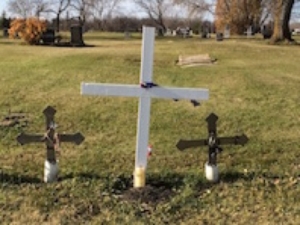The Red River North Region of Manitoba has some 59 cemeteries and burial sites. Our intent is to provide information concerning three of the cemeteries and to give teachers a practical guide that will show students how to gather historical evidence using these primary sources.
The three cemeteries we have chosen are St. Peter Dynevor Cemetery, St. Clements Mapleton Cemetery and the Eastern Selkirk Catholic Cemetery.
We are providing background information about the churches and the cemeteries. We are also focusing the activities around three stories that can be found in each cemetery.
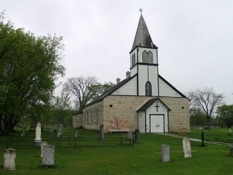
St. Peters Dynevor (Old Stone Church) CemeteryThis Anglican church tells the stories of the early peoples of the area and the settlers who first came. Many of the grave markers have been lost as they were made of wood and were easily destroyed by grass fires. |
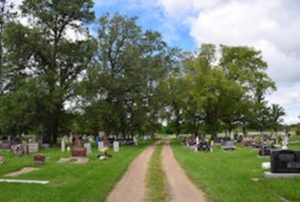
The East Selkirk Cemetery (Ukrainian Greek Catholic Cemetery)The East Selkirk Cemetery shows the early Eastern European migration and the headstones are symbolic of the many regions their families immigrated from. This cemetery is divided into three sections; Roman catholic, Ukrainian Greek and Orthodox. |
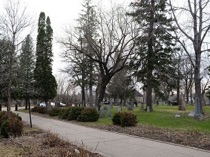
St. Clements Mapleton CemeterySt. Clements Cemetery is also Anglican and closely connected to the Selkirk community and the families who lived in that area. Many headstones are traditional British Isles design and the archived information is very detailed. |
|
|
Red River North Cemetery Project
The Red River North Region has some 59 cemeteries and burial sites as identified through a study conducted by the MB Genealogical Society. In order to provide some summaries and details, to educators, students and persons searching for genealogical information the Rural Municipality (RM) of St. Clements Heritage Advisory Committee (MHAC) successfully applied for a Manitoba Heritage Grant.
As a member of the Red River North Region Heritage Committee St. Clements Heritage Advisory Committee proposed:
- the development of an cemetery inventory for the Red River North Region with the contact information for as many cemeteries as possible.
- the identification of archival sources of information
- the identification of elders who could provide stories from the cemeteries
- the development of detailed descriptions of three of the major cemeteries; St. Peter Dynevor (Indigenous), Blessed Virgin Mary the Protectress (Ukrainian Catholic) and St. Clements Mapleton (Selkirk Community)
In order to fulfill these objectives in a way that could be used by teachers and students as well as members of the general public we created an inventory of all of the cemeteries with their contact information.
We then focused on one cemetery from each of three municipalities of the Red River North Region: St. Clements, St Andrews and the city of Selkirk. These three were used to create cemetery studies focused on historical themes and the family stories within the cemeteries. Teacher background information, student activities and online resources were created.
We would like to thank the Province of Manitoba’s Heritage Grant Program for the funding required to complete this project.
Why plan a trip to a cemetery?
Through cemeteries we are linked to the people of the past and we can begin to see how we are connected to the past.

St. Peter’s Dynevor Cemetery
Cemeteries help us to develop multiple perspectives of the past. They show us how different people, within our community, lived based on their wealth, cultural background, gender, age and length of time in the community. The stories of the community are revealed.
Cemeteries also show us what people’s attitudes to life were and what they considered to be important.
As well as history, they surround us with art and design that reflect changes in how materials and methods were used.
From a classroom perspective cemeteries provide a tangible resource for the development of historical and critical thinking skills. Many stories are evident if we learn how to read primary evidence.
Cemeteries may also provide students with ways to connect with their own families.
Preparing for your visit
- Ensure you receive permission to be in the cemetery. Many cemeteries are public but some are private.
- Discuss the historical reasons for visiting the cemetery and dispel any misconceptions. Provide students with a sense of what they might expect at the cemetery: different monuments, momentous left by loved ones, different types of cemeteries.
- Make an advance trip to the cemetery to make note of different headstone symbols and a list of other things students will see.
- As the teacher, prepare for questions from your students. Discussions are best done before the visit.
- Prepare a comprehensive letter to go to parents with clear explanations of the desired outcomes of the visit.
- Complete pre-trip activities such as identifying symbols representing different groups, identifying various shapes of markers etc.
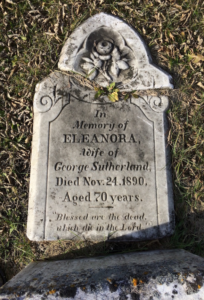
- Assign research roles to students. Students will be doing field research in the cemetery working as historians, scientists, artists, researchers, cartographers (mapmakers), reporters (written or oral), videographers if equipment is available.
- Discuss dressing appropriately for the weather. Do not forget to bring along sunscreen and insect repellent.
- Bring along a pencil, paper, camera and clipboard.
Cemetery expectations
There may be different rules for different cemeteries. Check what the rules are when you gain permission to visit the cemetery. Some general expectations of students and visitors are:
- Show respect for the cemetery.
- Stay on roads or paths if possible.
- Walk behind the monuments as you travel through the cemetery.
- Stand to the side of the grave to read the monument.
- Treat the headstones and markers with care. They are historical stone documents.
- Be careful with them. Do not push or lean on them. Some are very old and easily damaged.
- Headstones belong to the families who have installed them. Please treat them with respect.
Students may only know what they have seen on television or in movies about cemeteries. A starting point might be to ask what they think about when they hear the word cemetery.
Cemetery customs
Traditionally headstones faced east. East, the place of the rising sun was seen as birth. West the place of the setting sun was associated with death. This east west custom is seen in different cultures. When a Blackfoot tipi was set up the opening faced the east. In ancient Egypt towns and cities were built on the east side of the Nile River. The west side was used for the pyramids and tombs. East for living. West for the dead..
Some students may know of customs related to their culture that are similar to the east – west placement.
A Historic Resource
Students can study local, national and international history in a cemetery. The following are some ideas for student research or a guided tour.
How the community has changed
- Make a list of the different countries and cultures you see in the cemetery.
- Look at the names of the graves. Try to decide what countries the people came from.
- Do you see changes between old and new sections of the cemetery? What are they?
- If you find several names that appear to be from the same family can you create a family tree?
- Can you find evidence of catastrophes, plagues, wars or epidemics?
- Find names of groups that people have belonged to and tell what the symbol was. (Odd Fellows, Masons)
- Record dates and events from the headstones to create a timeline when you get back to class.
- Can you discover any jobs people did from what is written on the tombstone?
Famous People in the community
- Look for a grave of a well-known person from your community. What does it say about him/her on the headstone? Have you seen that name anywhere else in the community?
- Remind students that families buy the headstones. The material and size of the headstone reflects the cost. Families have different ways to mark their relatives. In the past they used one large headstone for the family name and the smaller footstones to mark each member.
- Can you see the changes in the headstones as you look farther into the past? Record a drawing of at least three different stones from different decades.
Military Headstones
- Is there an area where most of the veterans are buried? This is called a Field of Honour.
- Examine and study the military insignia and information written on the stone. Create a glossary of what the symbols and initials mean.
- Graph the military units represented in the cemetery. Research the units when you return to class.
- Graph or chart the ranks of the veterans.
- Graph the wars represented by the headstones.
- Return on Remembrance Day and with permission place Canadian flags on each of the veteran’s graves. Return to collect them on an agreed upon date.
- Use the information gathered to create a Veteran’s Trail in your school that displays all of the information gathered.
Reading Symbols
- Many symbols are used on headstones. Some of them indicate the spiritual beliefs of the person. They may show their nationality such as roses for England.
- Find the symbols on headstones and draw them or take photos. Discuss them when you get back to class.
Just Like a Historian / Historical Thinking Skills
- Have the students pretend they are historians researching information based on what they see in the cemetery. Ask them to create questions that they cannot find answers to in the cemetery. In the classroom have them identify sources where they might find the answer. They could continue to try to answer at least one of the questions.
